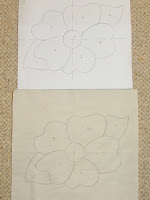Don’t you just love this time of year? The intense bright green of new shoots in the hedgerows heralds the arrival of warmer weather and lighter nights; it gladdens the heart and quickens the pulse. I am an optimist by nature, just a simple soul and I am rarely anything but happy and content. Spring is my season!
I continue to prepare for Paducah next month. But occasionally I look over my shoulder, with regret it has to be said, at the work that I have had to put to one side for the time being. Its day will come!
Work in progress
I have been invited, by QUILT magazine in the US, to reproduce the quilt from the front cover of my book ‘Dual Image Appliqué’. This is to appear in the fall issue so the leaf pattern will be topical. The fabrics, chosen from the Hoffman watercolour range, can only be described as delicious! Just look at those colours and textures.
Fabrics
When they arrived I couldn’t help but get started on the lap quilt and this has taken over my sewing time for most of this week.
Constructed squares
Positive and negative leaves
The procedure outlined in Blog 44 is followed. The difference here is that two fabrics, joined on the diagonal, make up the starting square. Three constructed squares make two blocks: 1 square with the fused pattern produces the frame and the fillers, the other 2 squares are foundations. One foundation goes behind the filler to give a positive appliqué and the other goes behind the frame to give a negative appliqué. The positioning of the frame and filler along to diagonal of the foundations is critical. Once ironed in place, the edge of the shape must be sewn to prevent fraying.
Satin stitch
I habitually place cotton batting behind where I am sewing to give the fabrics some body and to help prevent any tunnelling of the stitch and distortion of the fabric. I have chosen a cherry red thread and a small satin stitch for strong definition.
Satin stitch and batting
I am still working in the attic until the weather really warms up. I look forward to returning to my purpose-made workshop in the garage when I can comfortably sew there of an evening.
Sewing station in the attic
































